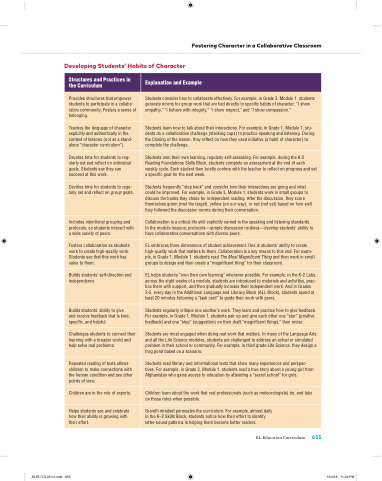Page 679 - EL Grade 5 Teacher Guide
P. 679
Fo ering Character in a Collaborative Classroom
Developing Students’ Habits of Character
Structures and Practices in the Curriculum
Explanation and Example
Provides structures that empower students to participate in a collabo- rative community. Fosters a sense of belonging.
Students consider how to collaborate effectively. For example, in Grade 3, Module 1, students generate norms for group work that are tied directly to speci c habits of character: “I show empathy,” “I behave with integrity,” “I show respect,” and “I show compassion.”
Teaches the language of character explicitly and authentically in the context of lessons (not as a stand- alone “character curriculum”).
Students learn how to talk about their interactions. For example, in Grade 1, Module 1, stu- dents do a collaborative challenge (stacking cups) to practice speaking and listening. During the Closing of the lesson, they re ect on how they used initiative (a habit of character) to complete the challenge.
Devotes time for students to reg- ularly set and re ect on individual goals. Students see they can succeed at this work.
Students own their own learning, regularly self-assessing. For example, during the K-2 Reading Foundations Skills Block, students complete an assessment at the end of each weekly cycle. Each student then brie y confers with the teacher to re ect on progress and set a speci c goal for the next week.
Devotes time for students to regu- larly set and re ect on group goals.
Students frequently “step back” and consider how their interactions are going and what could be improved. For example, in Grade 3, Module 1, students work in small groups to discuss the books they chose for independent reading. After the discussion, they score themselves green (met the target), yellow (on our way), or red (not yet) based on how well they followed the discussion norms during their conversation.
Includes intentional grouping and protocols, so students interact with a wide variety of peers.
Collaboration is a critical life skill explicitly named in the speaking and listening standards. In the module lessons, protocols—simple discussion routines—develop students’ ability to have collaborative conversations with diverse peers.
Fosters collaboration as students work to create high-quality work. Students see that this work has value to them.
EL embraces three dimensions of student achievement. One is students’ ability to create high-quality work that matters to them. Collaboration is a key means to this end. For exam- ple, in Grade 1, Module 1, students read The Most Magni cent Thing and then work in small groups to design and then create a “magni cent thing” for their classroom.
Builds students’ self-direction and independence.
EL helps students “own their own learning” whenever possible. For example, in the K-2 Labs, across the eight weeks of a module, students are introduced to materials and activities, prac- tice them with support, and then gradually increase their independent work. And in Grades 3-5, every day in the Additional Language and Literacy Block (ALL Block), students spend at least 20 minutes following a “task card” to guide their work with peers.
Builds students’ ability to give and receive feedback that is kind, speci c, and helpful.
Students regularly critique one another’s work. They learn and practice how to give feedback. For example, in Grade 1, Module 1, students pair up and give each other one “star” (positive feedback) and one “step” (suggestion) on their draft “magni cent things,” then revise.
Challenges students to connect their learning with a broader world and help solve real problems.
Students are most engaged when doing real work that matters. In many of the Language Arts and all the Life Science modules, students are challenged to address an actual or simulated problem in their school or community. For example, in third grade Life Science, they design a frog pond based on a scenario.
Repeated reading of texts allows children to make connections with the human condition and see other points of view.
Students read literary and informational texts that show many experiences and perspec- tives. For example, in Grade 3, Module 1, students read a true story about a young girl from Afghanistan who gains access to education by attending a “secret school” for girls.
Children are in the role of experts.
Children learn about the work that real professionals (such as meteorologists) do, and take on those roles when possible.
Helps students see and celebrate how their ability is growing with their effort.
Growth mindset permeates the curriculum. For example, almost daily in the K–2 Skills Block, students notice how their effort to identify letter-sound patterns is helping them become better readers.
EL Education Curriculum 655
_ELED.TG.05.01.indb 655
12/4/18 11:49 PM


